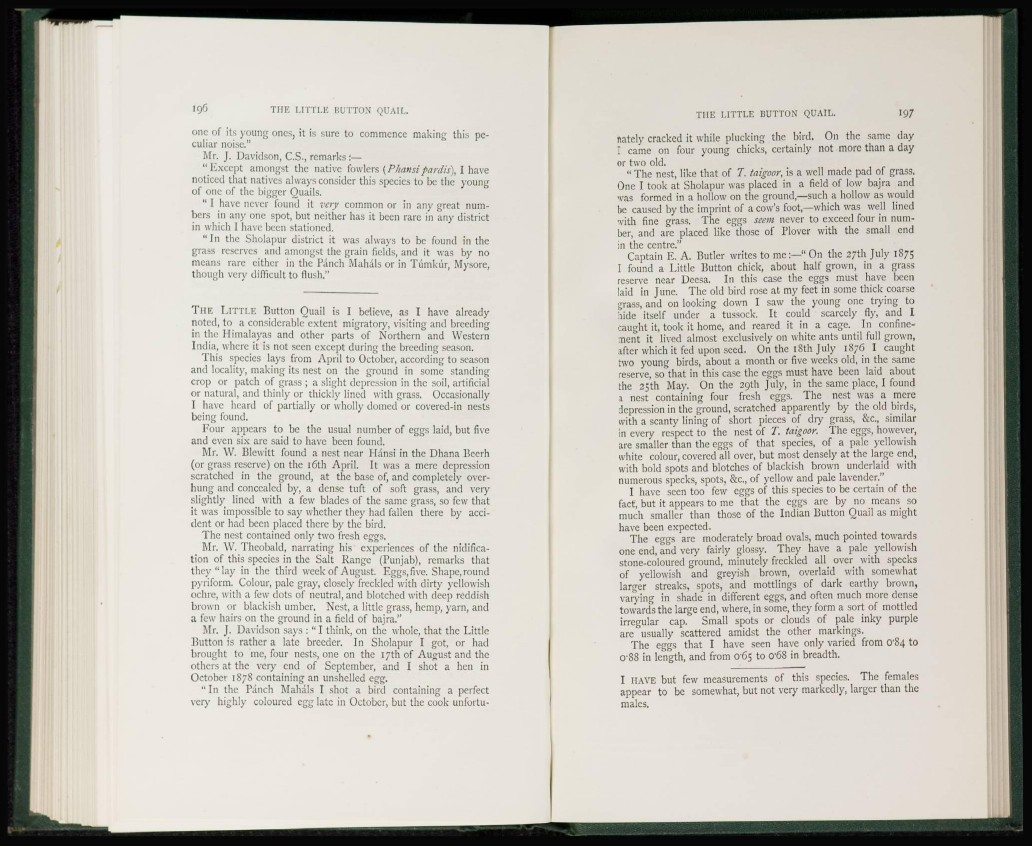
THE LITTLE BUTTON QUAIL.
one of its young ones, it is sure to commence making this peculiar
noise."
Mr. J. Davidson, C.S., remarks:—
"Except amongst the native fowlers (Phansipardis). I have
noticed that natives always consider this species to be the young
of one of the bigger Quails.
" I have never found it very common or in any great numbers
in any one spot, but neither has it been rare in any district
in which I have been stationed.
" in the Sholapur district it was always to be found in the
grass reserves and amongst the grain fields, and it was by no
means rare cither in the Punch Mahals or in Tumkur, Mysore,
though very difficult to flush."
THE LITTLE Button Quail is I believe, as I have already
noted, to a considerable extent migratory, visiting and breeding
in the Himalayas and other parts of Northern and Western
India, where it is not seen except during the breeding season.
This species lays from April to October, according to season
and locality, making its nest on the ground in some standing
crop or patch of grass ; a slight depression in the soil, artificial
or natural, and thinly or thickly lined with grass. Occasionally
I have heard of partially or wholly domed or covercd-in nests
being found.
Four appears to be the usual number of eggs laid, but five
and even six are said to have been found.
Mr. W. Blcwitt found a nest near Hansi in the Dhana Beerh
(or grass reserve) on the 16th April. It was a mere depression
scratched in the ground, at the base of, and completely overhung
and concealed by, a dense tuft of soft grass, and very
slightly lined with a few blades of the same grass, so few that
it was impossible to say whether they had fallen there by accident
or had been placed there by the bird.
The nest contained only two fresh eggs.
Mr. W. Theobald, narrating his experiences of the nidification
of this species in the Salt Range (Punjab), remarks that
they "lay in the third week of August. Eggs,five. Shape,round
pyriform. Colour, pale gray, closely freckled with dirty yellowish
ochre, with a few dots of neutral, and blotched with deep reddish
brown or blackish umber. Nest, a little grass, hemp, yarn, and
a lew hairs on the ground in a field of bajra."
Mr. J. Davidson says : " I think, on the whole, that the Little
Button is rather a late breeder. In Sholapur I got, or had
brought to me, four nests, one on the 17th of August and the
others at the very end of September, and I shot a hen in
October 1878 containing an unshclled egg.
" In the Punch Mahals I shot a bird containing a perfect
very highly coloured egg late in October, but the cook unfortu-
TIIE LITTLE BUTTON QUAIL. 197
nately cracked it while plucking the bird. On the same day
I came on four young chicks, certainly not more than a day
or two old.
" The nest, like that of T. taigoor, is a well made pad of grass.
One I took at Sholapur was placed in a field of low bajra and
was formed in a hollow on the ground,—such a hollow as would
be caused by the imprint of a cow's foot,—which was well lined
with fine grass. The eggs seem never to exceed four in number,
and are placed like those of Plover with the small end
in the centre."
Captain E. A. Butler writes to me:—"On the 27th July 1875
I found a Little Button chick, about half grown, in a grass
reserve near Deesa. In this case the eggs must have been
laid in June. The old bird rose at my feet in some thick coarse
grass, and on looking down I saw the young one trying to
hide itself under a tussock. It could scarcely fly, and I
caught it, took it home, and reared it in a cage. In confinement
it lived almost exclusively on white ants until full grown,
after which it fed upon seed. On the 1.8th July 1876 I caught
two young birds, about a month or five weeks old, in the same
reserve, so that in this case the eggs must have been laid about
the 25th May. On the 29th July, in the same place, I found
a nest containing four fresh eggs. The nest was a mere
depression in the ground, scratched apparently by the old birds,
with a scanty lining of short pieces of diy grass, &c, similar
in every respect to the nest of T. taigoor. The eggs, however,
are smaller than the eggs of that species, of a pale yellowish
white colour, covered all over, but most densely at the large end,
with bold spots and blotches of blackish brown underlaid with
numerous specks, spots, &c, of yellow and pale lavender."
I have seen too few eggs of this species to be certain of the
fact, but it appears to me that the eggs are by no means so
much smaller than those of the Indian Button Quail as might
have been expected.
The eggs are moderately broad ovals, much pointed towards
one end, and very fairly glossy. They have a pale yellowish
stone-coloured ground, minutely freckled all over with specks
of yellowish and greyish brown, overlaid with somewhat
larger streaks, spots, and mottlings of dark earthy brown,
varying in shade in different eggs, and often much more dense
towards the large end, where, in some, they form a sort of mottled
irregular cap. Small spots or clouds of pale inky purple
are usually scattered amidst the other markings.
The eggs that I have seen have only varied from 084 to
0-88 in length, and from 0*65 to 068 in breadth.
I HAVE but few measurements of this species. The females
appear to be somewhat, but not very markedly, larger than the
males.